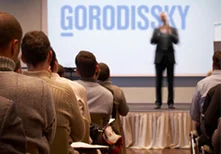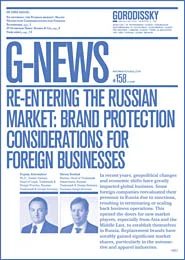Parallel imports in Russia: same game, different rules
29 November 2018This article first appeared in World Trademark Review issue 76, published by Globe Business Media Group – IP Division. To view the issue in full, please go to www.WorldTrademarkReview.com
It is difficult to imagine an IP issue that is more of a headache for trademark owners than parallel imports. Perhaps only outright counterfeiting causes more problems.
Golden age
The parallel import regime has undergone significant transformations over time. However, for more than a decade Russian court practice was uniform and clear: the parallel import of goods was prohibited, and grey goods imported into Russia without the consent of the trademark owner were considered to be counterfeits. Administrative as well as civil suits could be initiated against infringers. This was a golden age for trademark owners, since parallel imports were subject to the same treatment as counterfeit goods.
In 2008 the Supreme Commercial Court stated that there were two kinds of counterfeit good:
- where a trademark was unlawfully placed on the product; and
- where the labelled product was imported into Russia without the trademark owner’s permission.
Civil suits became the only (albeit very efficient) remedy that could be applied to parallel imports. Subsequently, Customs could detain parallel goods for 10 days (extendable by a further 10 days) and inform trademark owners of the consignment containing parallel goods. The trademark owners could initiate a civil case during that term and obtain a judgment providing for the destruction of the parallel goods and payment of damages or compensation by the parallel importer.
Liberalisation
Parallel importers became increasingly upset by this judicial trend and started lobbying for the liberalisation of parallel imports, prompting the Federal Anti-monopoly Body to launch a liberalisation campaign. Discussions lasted for several years without any tangible result, but the body eventually proposed a compromise: in order to make liberalisation easier, it suggested that only limited groups of goods (eg, automobile spare parts, pharmaceutical products and medical equipment) should be allowed to be imported without the trademark owner’s consent. Nevertheless, if the production of such goods was localised in Russia, the national exhaustion of rights should be retained.
Regional exhaustion of rights
Russia, Belarus, Kazakhstan, Armenia and Kyrgyzstan set up the Eurasian Economic Union (EAEU). The members of the EAEU agreed on the regional exhaustion of rights, meaning that goods which have been legally imported or sold within EAEU territory by the trademark owner or with the owner’s consent can be freely resold or exported to another member state of the EAEU. Discussions on liberalisation were also held within the EAEU framework, specifically at the Eurasian Economic Commission, which is responsible for drafting proposals to be adopted by a consensus of representative bodies of member states. The commission held a number of meetings over several years but failed to reach a coordinated decision, largely because Belarus was a steadfast supporter of national (regional) exhaustion of rights and opposed international exhaustion.
Sony decision
During the discussions, Russian courts continued issuing judgments against parallel importers.
In 2015 Russian company PAG Ltd imported thermal paper bearing the SONY trademark for healthcare ultrasound machines from Poland. The import was not authorised by the trademark owner Sony Corporation. Sony seized the imported paper and sued PAG, asking the court to:
- prohibit illegal use of the SONY trademark;
- confiscate and destroy the imported goods; and
- collect monetary compensation from the infringer.
Sony prevailed in all court instances. As a last resort, PAG tackled the problem from a different angle and complained to the Constitutional Court, arguing that several provisions of the Civil Code that could be applied to parallel importation were unconstitutional.
The court examined the issue of parallel imports and issued the final decision on 13 February 2018. It recognised that parallel imports create a conflict of interest between trademark owners and parallel importers. The court confirmed the principle of regional exhaustion of rights in Russia as part of the EAEU, meaning that – by virtue of law – parallel imports in Russia are prohibited.
However, this principle should not be applied automatically or without consideration for all circumstances, including the good faith of the trademark owner. The Constitutional Court stated that the globalisation of world trade and economic penalties imposed on Russia have brought the legal issue of exhaustion of rights to the fore and it should now be considered with greater attention. The court explained that the law governing the national exhaustion of rights should be used in conjunction with the principles of the Constitution and with consideration for other provisions of the civil law.
The court pointed out that a trademark owner may abuse its exclusive right and either limit the supply of goods to the Russian market or determine its pricing policy in such a way that the prices for its products are inordinately high. Trademark owners should also be prohibited from abusively using their trademark rights to restrict the import of certain selected goods of public interest (eg, drugs and life-support equipment) or providing overpricing policy in Russia in comparison with other countries. The court may raise the issue of the good faith of the trademark owner, which may need to prove that its lawsuit is not an abuse of trademark rights and that a ban on parallel imports will not jeopardise the health and life of people or pose a risk to public interest. In case of abuse of rights, a trademark owner’s claims should be dismissed.
According to the decision, damage suffered by a trademark will differ according to whether the owner is selling unauthorised original goods or counterfeit goods. Therefore, recognising a trademark owner’s right to prevent the unauthorised import of goods to Russia, the Constitutional Court ruled that the legal consequences for the same actions with respect to grey products and counterfeit goods should not be the same.
In particular, the amount of compensation for parallel imports should be less than that levelled on the import of fake goods. The courts are free to reduce the claimed amount of compensation at their own discretion, depending on the circumstances of the case and the possible negative consequences for the trademark owner. The destruction of goods imported into Russia as a result of parallel imports will be permitted only:
- if the goods are of low quality;
- for reasons of security;
- to safeguard people’s health and life; and
- to protect the environment and cultural values.
Sony’s case against PAG was sent back to the first-instance court for reconsideration in view of the position of the Constitutional Court. During this reconsideration, Sony stated that it was best to use the imported thermal ultrasound paper within three years of manufacture. Given that the goods imported by PAG were seized at the border and kept at the warehouse during the court case (which took more than three years), the paper was no longer suitable for use. Thus, PAG was unable to guarantee that the goods remained in usable and acceptable quality.
As a result of the reconsideration, the first-instance court satisfied the claims of the trademark owner and stated that the goods imported by PAG should be confiscated for destruction, and that the importer should pay monetary compensation for the trademark infringement to the rights holder (to the minimum amount established by civil law).
Comment
Several cases were initiated by different trademark owners against parallel importers after the Constitutional Court announced its decision. In such cases, the rights holders tried to limit their claims and prevent only grey goods from being introduced onto the market without claiming their seizure and destruction through the lawsuit. For example, in one case, the trademark owner managed to ban the parallel importer from importing into Russia the goods bearing the plaintiff’s trademark. It may be assumed that parallel goods may be further re-exported or destroyed by the parallel importer itself if it believes that re-export would be more expensive than destruction.
In analysing such cases, it remains possible to enforce trademark rights against parallel imports in Russia. It is clear that the Constitutional Court decision is a compromise caused by the economic penalties imposed on Russia by some countries. The court could not introduce international exhaustion of rights because Russia is a member of the EAEU, which has adopted the principle of regional exhaustion. In order to legalise parallel imports, it would be necessary to change Russia’s international commitments within the EAEU framework. However, this appears unachievable.










